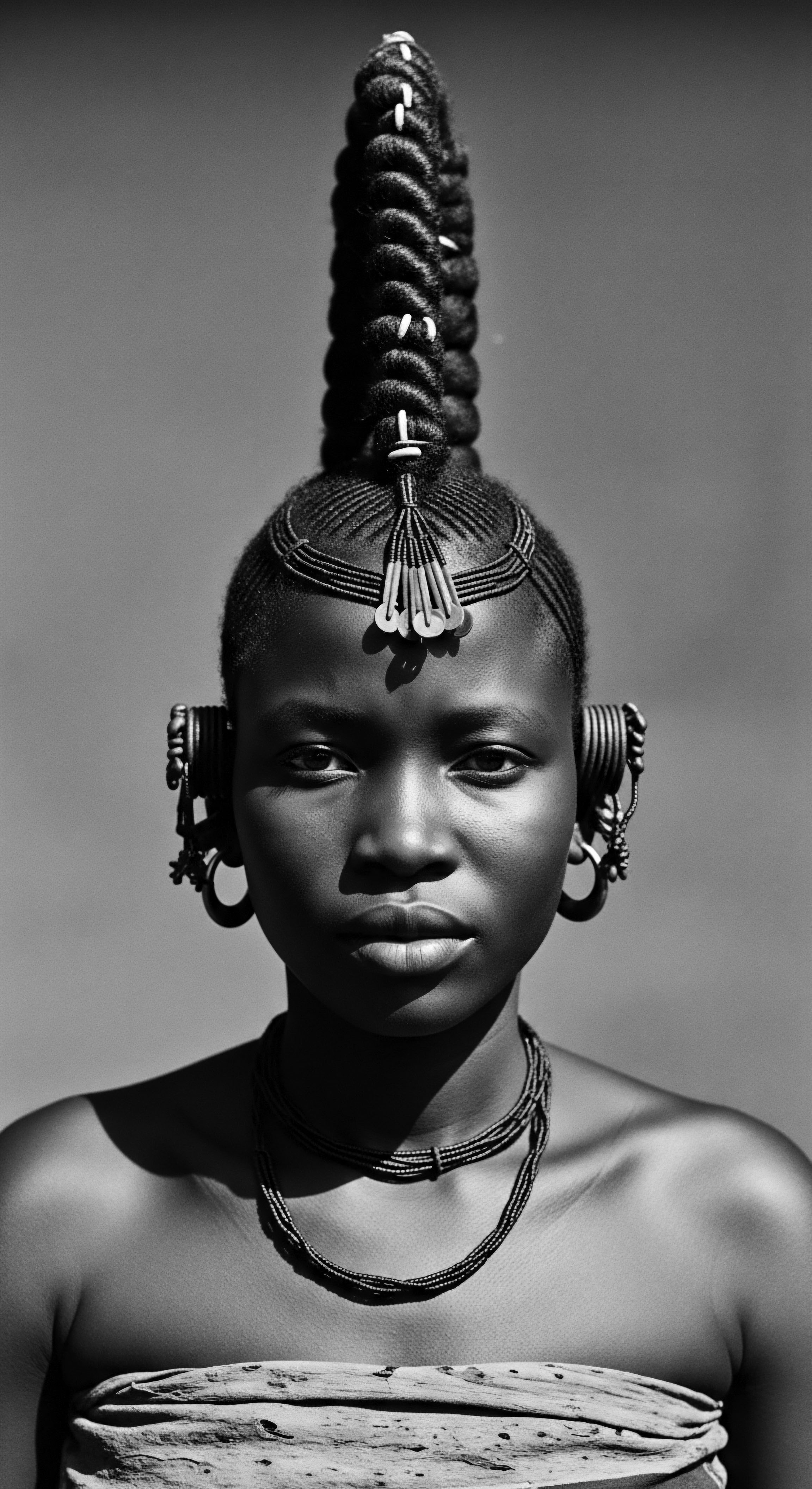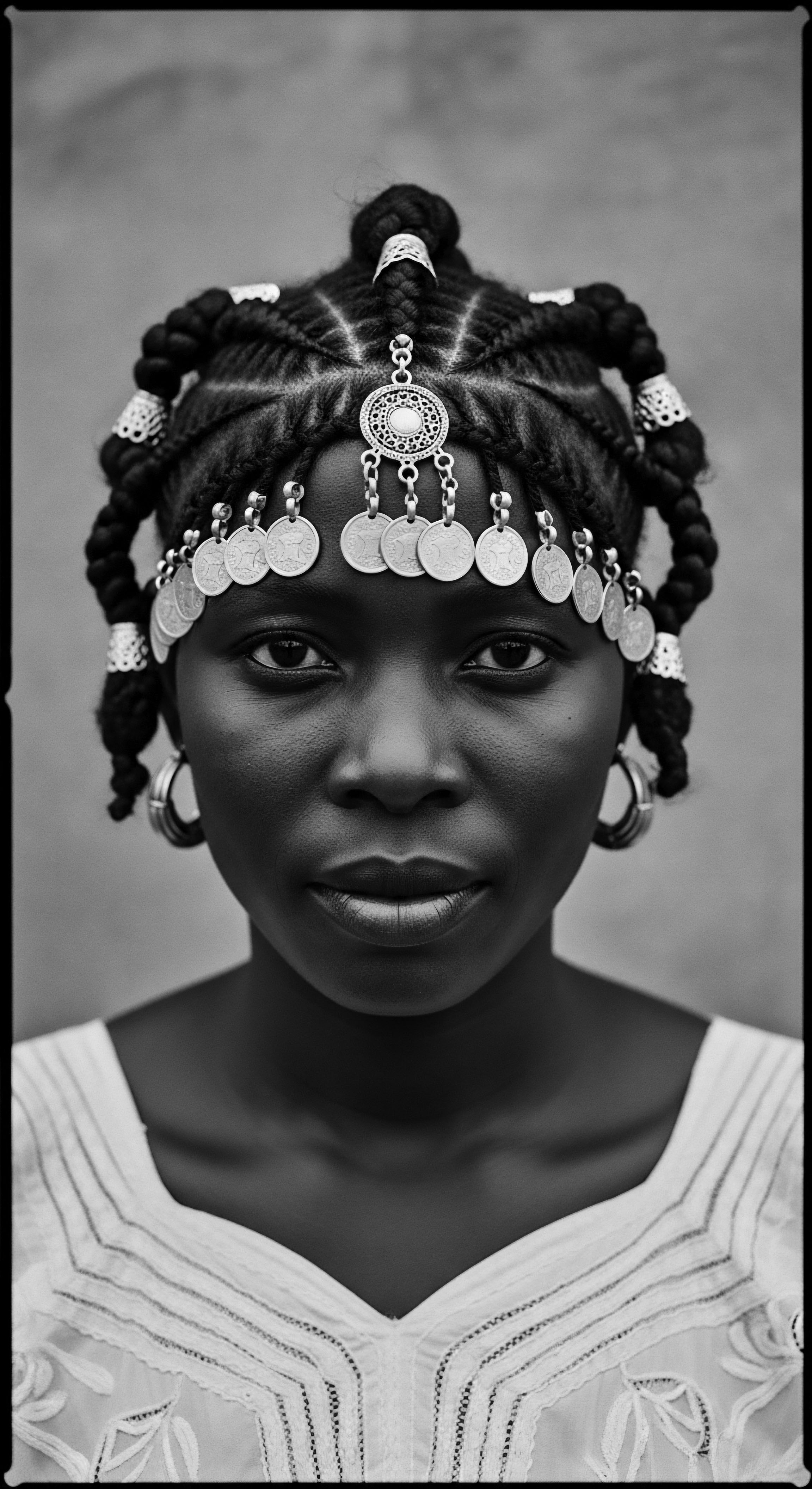
Fundamentals
The Slave Trade, a stark and somber period in human history, designates the organized, systemic trafficking of human beings, primarily those of African descent, for forced labor and chattel slavery across vast geographical expanses. This global enterprise, spanning centuries, represented a profound upheaval, displacing millions from their ancestral lands and severing ties to established cultural norms. Its meaning extends beyond mere commerce; it speaks to the systematic denial of human dignity, the imposition of brutal economic systems, and the deliberate erosion of individual and communal identity. The transatlantic leg, often termed the Triangular Trade, specifically involved the forced transportation of enslaved Africans across the Atlantic Ocean to the Americas, profoundly reshaping societies on three continents.
For communities across Africa, hair held deeply rooted cultural significance, functioning as a silent language of identity, spiritual connection, and societal standing. Before the commencement of the horrific trafficking, a person’s hairstyle could communicate their lineage, their marital status, age, wealth, and even their tribal affiliation. Hair was often considered the most elevated part of the body, a conduit to the divine, particularly among the Yoruba people, who used braided styles to send messages to their gods.
Elaborate styling, a communal ritual lasting hours or even days, fostered profound bonds between individuals, weaving social fabric and reinforcing kinship. These intricate patterns, often unique to specific ethnic groups, were more than mere aesthetics; they embodied history, conveyed wisdom, and articulated belonging.
Hair, in pre-colonial African societies, served as a vibrant lexicon of identity, communicating lineage, marital status, and spiritual connection.
The brutal initiation into the transatlantic Slave Trade often began with a jarring act of profound desecration ❉ the forced shaving of hair. This was not a sanitary measure, as enslavers sometimes claimed, but a calculated, deliberate act of dehumanization. It aimed to erase African identities, stripping individuals of their visible connections to family, tribe, and spiritual heritage. The loss of hair, so intricately tied to self-perception and community recognition, served as a powerful, violent declaration of a new, degraded status.
It was a tangible severing of ties, a cruel attempt to obliterate the very memory of who they were before bondage. This initial assault set the stage for generations of struggle to reclaim and redefine textured hair heritage in the diaspora.

Intermediate
The forced journey from West Africa to the Americas, an ordeal of unspeakable cruelty, systematically dismantled the rich tapestry of African life, including its deeply ingrained hair traditions. Enslaved individuals, stripped of their tools, traditional ingredients, and the precious communal time once dedicated to hair care, faced unprecedented challenges in maintaining their tresses. The damp, unsanitary conditions aboard slave ships, combined with starvation and brutal treatment, left hair matted, tangled, and often infested, creating a stark contrast to the meticulously cared-for styles of their homelands. This degradation was a calculated part of the dehumanization process, designed to strip away self-worth and communal pride.

The Erosion of Ancestral Practices
The meticulous hair care rituals, which once sustained not only the physical health of textured hair but also the spiritual and social well-being of individuals, gradually eroded under the oppressive weight of chattel slavery. Natural butters, herbs, and powders, traditionally used to nourish and retain moisture, became scarce or inaccessible. Combs, often intricately carved symbols of tribal identity, were forbidden or lost.
The forced labor on plantations left little time or energy for the hours-long styling sessions that were once central to social life. Sundays, often the only day of respite, frequently became the singular opportunity for communal hair care, transforming a daily ritual into a desperate act of preservation and connection.
In the face of relentless oppression, enslaved Africans found ways to adapt and resist, quietly asserting their humanity through their hair. While forced to cover their hair with scarves or kerchiefs, particularly field slaves, these head coverings often concealed not only neglected hair but also a defiant spirit. The act of head-wrapping itself, while sometimes imposed by law, also held deep roots in West African traditions, becoming a visual marker of identity for many in the diaspora. This adaptation, born of necessity, also became a symbol of enduring cultural continuity, showcasing resilience.

Hair as a Repository of Covert Communication
Perhaps one of the most remarkable displays of ingenuity and resistance came in the covert use of hair as a medium for communication and survival. Enslaved women, harnessing the unique tensile strength and coil patterns of textured hair, transformed cornrows into intricate maps and secret repositories. This particular aspect of hair heritage, steeped in urgency and daring, powerfully speaks to the ingenuity of a people determined to defy their chains.
Cornrows were transformed into clandestine cartographies and secret caches, showcasing the ingenuity of enslaved Africans.
Accounts from various parts of the Americas attest to this practice. In Colombia, for instance, enslaved Africans led by Benkos Biohó, who escaped and founded the free village of Palenque de San Basilio in the early 17th century, are said to have pioneered the use of cornrows as coded messages. Women would braid specific patterns into their hair to indicate safe routes, water sources, or meeting points for those planning to escape. A coiled braid might signify a mountain, a sinuous pattern a river, and thicker braids could denote the presence of soldiers.
This silent language, passed down through generations, allowed for the clandestine transfer of vital information without arousing the suspicion of overseers. It was a profound act of resistance, leveraging an inherent aspect of their physical being for collective liberation.
Beyond mapping freedom, these intricate braids also served as a means to carry tangible resources for survival. Enslaved West African women, particularly those with knowledge of rice cultivation, ingeniously braided rice seeds into their hair before being forced onto slave ships. This practice, later confirmed by researchers like ethnobotanist Tinde van Andel, ensured the transfer of critical food staples and agricultural knowledge to the New World.
These hidden seeds, painstakingly preserved, not only provided sustenance for escapees but also laid the groundwork for new agricultural economies in the Americas, directly connecting ancestral knowledge to economic development through immense suffering. This powerful narrative underscores the deeply intertwined relationship between heritage, hair, and the enduring spirit of survival.
The communal nature of hair styling, even under duress, became a vital act of self-preservation. These moments, often stolen in the quiet of the night or on designated days of rest, were opportunities for maintaining cultural continuity, sharing stories, and fostering community bonds. The hands that braided were not just styling; they were transmitting heritage, whispering tales of resilience, and weaving connections that transcended the brutal realities of their existence. This enduring tradition of communal care continues to hold deep significance within Black and mixed-race hair experiences today, serving as a powerful reminder of ancestral solidarity.
| Pre-Colonial African Practice Elaborate Braiding (signifying status, identity) |
| Adaptation During Enslavement Covert communication through patterns (maps, messages); practical management of hair for labor |
| Enduring Heritage Connection Modern cornrows, braids, and twists as symbols of identity and resistance |
| Pre-Colonial African Practice Natural Ingredient Use (oils, herbs for moisture) |
| Adaptation During Enslavement Scarcity led to using whatever was available (kerosene, butter, bacon grease) |
| Enduring Heritage Connection Renewed interest in natural ingredients; emphasis on moisture retention for textured hair |
| Pre-Colonial African Practice Communal Styling Rituals (social bonding, spiritual connection) |
| Adaptation During Enslavement Limited to Sundays or stolen moments; became vital for maintaining community ties and cultural memory |
| Enduring Heritage Connection Hair salons and home styling sessions as community hubs, intergenerational knowledge transfer |
| Pre-Colonial African Practice Hair as Spiritual Conduit (highest body part, connection to divine) |
| Adaptation During Enslavement Forced shaving as dehumanization; spiritual significance often internalized or practiced in secret |
| Enduring Heritage Connection The concept of hair as sacred; spiritual cleansing and protective styling practices |
| Pre-Colonial African Practice These adaptations highlight the profound resilience and ingenuity of enslaved Africans, transforming tools of oppression into vessels of cultural survival and enduring ancestral wisdom. |

Academic
The Slave Trade, at its deepest interpretation, represents a complex historical phenomenon defined by the coerced movement of human beings for economic exploitation, intrinsically linked to the dismantling of indigenous societies and the imposition of a racialized caste system. Its meaning extends to the systematic dehumanization, cultural obliteration, and economic structuring that underpinned centuries of global commerce. This delineation requires an examination of the historical mechanisms of capture, transportation, sale, and forced labor, alongside the profound, enduring consequences on individual and collective identities, particularly concerning textured hair heritage. The scholarship surrounding this period reveals not only the brutality of enslavement but also the extraordinary resilience of those subjected to it, often expressed through subtle yet powerful acts of cultural preservation.
One compelling, yet often under-examined, dimension of the Slave Trade’s impact on African identity and resistance lies in the ingenious manipulation of hair by enslaved women to encode information and preserve ancestral knowledge. This practice transcends mere anecdote, standing as a testament to the sophisticated understanding of communal intelligence and the human spirit’s capacity for defiance under the most dire circumstances. The anthropologist and historian alike recognize in this an act of profound cultural agency, transforming a visible aspect of self into an instrument of liberation.

The Braided Cartographies of Freedom
Within the brutal confines of plantation life, where literacy was forbidden and overt communication carried severe penalties, enslaved African women transformed their hair into clandestine maps. This remarkable practice, particularly prevalent in regions like Colombia, where Maroon communities formed, demonstrates an extraordinary application of traditional braiding techniques for subversive purposes. These weren’t simply decorative styles; they were vital guides to freedom, meticulously constructed with purpose. A specific pattern, for instance, might delineate a river’s winding course, while another might represent a mountain range, guiding escapees through treacherous terrain.
The density and direction of cornrows, or even the inclusion of small knots, conveyed specific geographical features and safe havens. It was a silent language, a complex code understood only by those initiated into its meaning, creating an invisible network of solidarity and hope amidst pervasive surveillance.
Beyond directional cues, these braided repositories held tangible instruments of survival. Ethnobotanical studies and historical accounts reveal that enslaved West African women, understanding the agricultural bounty of their homelands, braided rice seeds into their hair before being forcibly transported across the Atlantic (Rose, 2020). This daring act of preservation ensured the continuation of vital crops in the Americas. More than 10 million Africans were forcibly transported during the transatlantic Slave Trade, yet it was the knowledge and resilience of these women, literally carrying their heritage within their strands, that allowed for the successful cultivation of rice in new lands.
This contribution, often misattributed to European ingenuity, underscores the profound, unacknowledged scientific and agricultural prowess brought by enslaved Africans. The intricate weave of their hair served as a living ark, safeguarding biodiversity and sustenance.
- Cornrow Patterns functioned as topographical maps, delineating escape routes, water sources, and rendezvous points.
- Hidden Seeds, particularly rice grains, braided into the hair ensured the transfer of critical agricultural knowledge and future sustenance to the Americas.
- Small Fragments of Gold or other valuables were sometimes concealed within the tight coils, providing a minimal means of survival once freedom was attained.

The Tignon Law and the Assertion of Self
The control over Black hair extended beyond practical suppression to explicit legal mechanisms designed to enforce racial hierarchy. A stark example is the Tignon Law, enacted in Louisiana in 1786. This ordinance mandated that Black women, whether free or enslaved, cover their hair with a tignon or headwrap in public. The stated intent was to mark their perceived inferior status relative to white women, particularly those of mixed heritage whose elaborate hairstyles and appearances challenged existing social norms.
However, in a remarkable act of defiance, these women transformed an instrument of subjugation into a symbol of pride and resistance. They adorned their mandated headwraps with vibrant, luxurious fabrics and intricate designs, transforming a badge of inferiority into a powerful declaration of their beauty, style, and inherent worth. This reappropriation of the tignon illustrates the dynamic interplay between oppressive systems and the enduring human spirit’s capacity for self-expression. It showcases how even under legal duress, cultural aesthetics became a battleground for identity.

The Legacy of Pathologization and Resistance
The Slave Trade not only attempted to strip away identity but also introduced a damaging system of racialized beauty standards that persist in some form today. Enslaved individuals with hair textures and features deemed more “European” were often given preferential treatment, such as less arduous domestic work, while those with tightly coiled, “kinky” hair were relegated to the brutal realities of field labor. This created an internal hierarchy within the enslaved community, forcing a perception that their natural hair was somehow inferior or “bad”. This historical pathologization of textured hair was a potent tool of social control, aimed at degrading Blackness and maintaining white supremacist social order.
Scholarly work by sociologists and cultural theorists has illuminated how this historical devaluation, stemming from the imperial aesthetic imposed during slavery, continues to shape perceptions of Black hair in contemporary society. The systemic conditioning to despise one’s natural hair, a tragic inheritance of enslavement, has unfortunately been perpetuated through generations. Yet, the consistent thread across centuries has been the unwavering spirit of resistance.
The Afro, the dreadlock, the cornrow—these styles became powerful political statements, rejecting Eurocentric beauty standards and affirming Black pride during movements for civil rights. This continued reclamation of natural hair serves as a profound counter-narrative, a vibrant living archive of resilience.
The understanding of textured hair’s unique biological properties, often misunderstood or devalued by dominant Western perspectives, finds its scientific validation in ancestral practices. For instance, the tight curl pattern of Black hair, which was once pejoratively labeled as “woolly” or “animalistic”, is now recognized by trichologists for its distinct structural characteristics that necessitate specific moisture-retention and protective styling approaches. The traditional African practices of oiling, braiding, and protective wrapping were, in essence, early forms of scientific hair care, intuitively designed to maintain the integrity of hair that thrives with careful management. These ancestral methods, born of intimate knowledge of hair’s elemental biology and passed down through generations, stand as robust examples of practical science interwoven with cultural wisdom, challenging the very notion of a “civilizing” influence where knowledge already existed.
- Hair Texture became a determinant of social standing and labor assignment within the plantation system, reinforcing racial hierarchies.
- Eurocentric Beauty Ideals were imposed, leading to the internalizing of negative self-perceptions regarding natural Black hair.
- The Tignon Law exemplifies legal control over Black women’s hair, forcing head coverings but ironically leading to creative defiance.
- Modern Natural Hair Movements represent a powerful continuation of historical resistance, reclaiming and celebrating ancestral hair forms.

Reflection on the Heritage of Slave Trade
The enduring heritage of the Slave Trade continues to cast a long shadow, yet within that darkness, stories of light, resilience, and profound beauty persist. The meaning of this historical period is not static; it lives within the texture of a strand, the rhythm of a comb through curls, and the vibrant hues of a headwrap. For those with textured hair, particularly Black and mixed-race individuals, their hair is a living archive, a direct connection to the ancestral spirit of defiance and survival. Each coil, each kink, each carefully crafted braid tells a story of journeys taken, hardships endured, and identities fiercely protected.
The deliberate efforts to erase African hair heritage during enslavement, from forced shaving to the imposition of Eurocentric beauty standards, were ultimately unsuccessful in stifling the spirit of creativity and self-determination. Instead, these oppressive measures unwittingly became catalysts for new forms of cultural expression and resistance. The ingenious use of braids to map escape routes or conceal precious rice seeds speaks to a profound ancestral wisdom, a deep intuitive science that understood how to leverage the very biology of hair for survival and the continuity of life itself. These narratives offer invaluable lessons in resilience, demonstrating how even in the face of absolute powerlessness, a community can find ways to communicate, nourish, and sustain its heritage through the most intimate of physical attributes.
The hair of textured communities stands as a living testament to ancestral resilience, a vibrant archive of defiance and survival.
Today, the resurgence of natural hair movements globally is a powerful echo of this historical resistance. It is a conscious, joyous reclamation of ancestral beauty, an affirmation of self-worth that pushes back against centuries of imposed narratives of inferiority. When we care for our textured hair with ancestral oils, engage in communal styling sessions, or choose to wear our natural coils with pride, we are not merely engaging in beauty practices; we are participating in a sacred ritual, honoring the strength and ingenuity of those who came before us. We are weaving a tender thread from the past to the present, ensuring that the legacy of those who used their hair as a beacon of freedom continues to illuminate our path.
The unbound helix of textured hair, therefore, becomes a symbol not only of historical struggle but of vibrant, self-determined futures rooted firmly in the wisdom of our shared heritage. It is a journey of continuous discovery, connecting ancient practices with contemporary understanding, inviting all to appreciate the profound stories held within each strand.

References
- Byrd, A. & Tharps, L. L. (2001). Hair Story ❉ Untangling the Roots of Black Hair in America. St. Martin’s Publishing.
- Gordon, M. (quoted in Omotos, A. (2018). The “Dreaded” Colonial Legacy of African Hair. Journal of Pan African Studies).
- Johnson, R. G. & Bankhead, A. (2014). Styling Black Hair in America ❉ A Cultural History. University Press of Mississippi.
- Lashley, M. (2021). The importance of hair in the identity of Black people. Nouvelles pratiques sociales, 31(2), 206–227.
- Mercer, K. (1987). Black Hair/Style Politics. Sage Publications.
- Omotos, A. (2018). The “Dreaded” Colonial Legacy of African Hair. Journal of Pan African Studies.
- Rose, S. (2020). How Enslaved Africans Braided Rice Seeds Into Their Hair & Changed the World .
- Sherrow, V. (2006). Encyclopedia of Hair ❉ A Cultural History. Greenwood Press.
- Simon, D. (cited in Heaton, S. (2021). Hair ❉ Public, Political, Extremely Personal ).
- Tate, S. A. (2009). Black Skins, Black Masks ❉ Hybridity, Dialogism, Performativity. Ashgate Publishing.
- Thompson, E. (2009). The Black Woman’s Guide to Living with Her Hair. Broadway Books.
- Yerima, A. (2017). The Imperial Aesthetic ❉ Race and Beauty in the Global South. Duke University Press.
